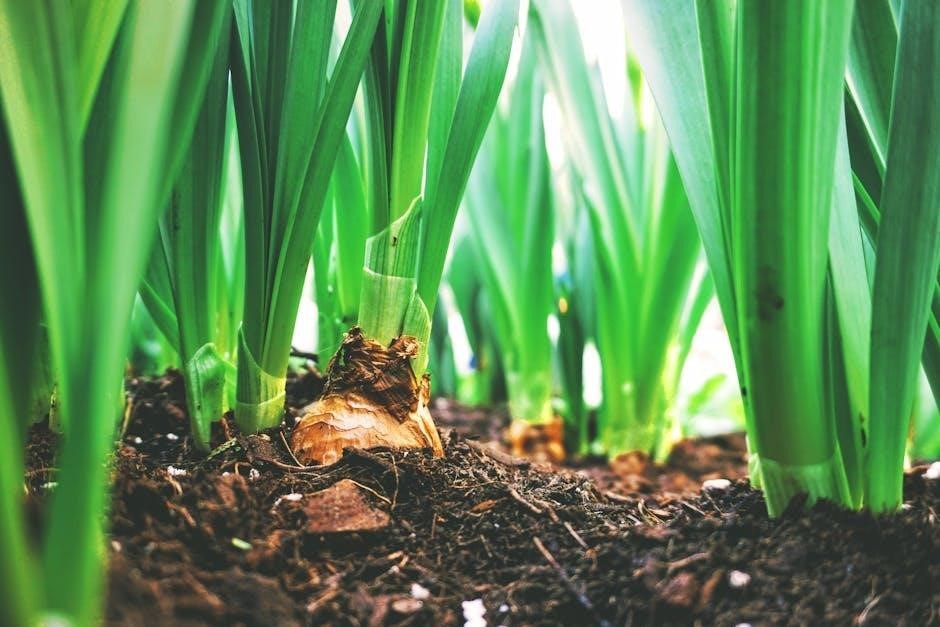Canada’s Zone 3a presents unique gardening challenges due to its cold climate and short growing season. This guide offers essential tips and recommendations for successful gardening in this region, focusing on plant selection, soil preparation, and extending the growing season.
Understanding Zone 3a Climate
Zone 3a, prevalent in regions of Canada, is characterized by its pronounced seasonal shifts, moving from extremely cold winters to short, milder summers. This climate presents a unique set of challenges and opportunities for gardeners. The USDA Plant Hardiness Zone Map divides areas based on minimum winter temperatures, with Zone 3a experiencing average lows between -40°F to -35°F (-40°C to -37.2°C).
Understanding these temperature ranges is crucial for selecting plants that can survive the harsh winters. The short growing season also necessitates careful planning, including starting seeds indoors and utilizing season extension techniques. Despite these challenges, a well-planned garden can thrive in Zone 3a, producing a variety of vegetables and fruits;
Characteristics of Zone 3a
Zone 3a presents a distinct set of characteristics that significantly influence gardening practices. The defining feature is its harsh winter, with minimum average temperatures plummeting to between -35°F and -40°F; This necessitates selecting extremely cold-hardy plant varieties capable of surviving such conditions. The growing season in Zone 3a is notably short, typically spanning from late May or early June to early September.
This limited timeframe demands efficient planning and execution, often involving starting seeds indoors to extend the growing period. Additionally, gardeners in Zone 3a must contend with potential late spring and early fall frosts, requiring protective measures like row covers or cold frames. Despite these challenges, the long summer days can promote vigorous growth for appropriately chosen plants.
Minimum Average Temperatures in Zone 3a
The defining characteristic of Zone 3a is its frigid winter climate, primarily dictated by the minimum average temperatures experienced annually. These temperatures range from a chilling -35°F to -40°F (-37.2°C to -40°C). This extreme cold dictates which plants can survive in this zone without significant protection.
Understanding these temperature thresholds is crucial for selecting appropriate plant species, as only those rated for Zone 3 hardiness or lower can reliably withstand the winter conditions. Gardeners must factor in these minimum temperatures when planning their gardens to ensure the survival and success of their plants, and protect them adequately during the colder months. Plant hardiness is key for Zone 3a success.
Challenges of Gardening in Zone 3a
Gardening in Zone 3a presents several significant obstacles. The most prominent challenge is the extremely short growing season, constrained by late spring frosts and early autumn freezes. This limited timeframe necessitates careful planning and efficient use of time. The soil may also remain cold for extended periods, hindering root development and nutrient uptake.
Cooler summer temperatures, even at noon, can impede the growth of heat-loving plants like melons and peppers, often preventing them from fully maturing. Supplemental heat and protective measures are often necessary to cultivate a wider variety of crops. Selecting cold-hardy varieties and employing season extension techniques become crucial for success.

Essential Gardening Tips for Zone 3a
Success in Zone 3a requires starting seeds indoors, utilizing greenhouses, and amending the soil. Choosing cold-hardy plants and employing season extension techniques are also critical for a bountiful harvest.
Starting Seeds Indoors
In Zone 3a, with its short growing season, starting seeds indoors is crucial for a successful garden. This allows plants to develop before the last frost, giving them a head start. Begin 6-8 weeks before the expected last frost date. Use seed-starting trays or pots with a quality seed-starting mix. Provide adequate light, either natural or artificial, for at least 14-16 hours a day.
Maintain consistent moisture, but avoid overwatering to prevent damping-off. Harden off seedlings gradually by exposing them to outdoor conditions before transplanting. This process acclimates them to the cooler temperatures and stronger sunlight, minimizing transplant shock. Remember to label each tray.
Using Greenhouses or Cold Frames
In Zone 3a, greenhouses and cold frames are invaluable for extending the growing season. Greenhouses provide a controlled environment, allowing you to start plants earlier and continue growing later into the fall. Cold frames, simpler structures, offer protection from frost and wind, enabling you to harden off seedlings or grow cool-season crops.
Choose a location that receives ample sunlight. Monitor temperature and ventilation to prevent overheating. Use row covers inside for added protection during extreme cold. Cold frames are particularly useful for overwintering hardy plants or starting seeds in early spring. Both options significantly enhance gardening possibilities in Zone 3a.
Amending the Soil
Amending the soil is crucial for successful gardening in Zone 3a Canada, where the ground can be poor and the growing season short. Start by testing your soil’s pH and nutrient levels to identify deficiencies. Incorporate organic matter like compost, well-rotted manure, or peat moss to improve soil structure, drainage, and fertility.
These amendments help retain moisture, which is vital during dry spells. Adding slow-release fertilizers provides essential nutrients throughout the growing season. Consider using raised beds filled with a high-quality soil mix for better control and drainage. Regularly adding organic matter will improve soil health and promote robust plant growth.
Choosing the Right Plants for Zone 3a
Selecting plants suited for Zone 3a is essential for gardening success in Canada’s harsh climate. Prioritize cold-hardy varieties that can withstand minimum average temperatures of -35°F to -40°F. Look for plants specifically labeled for Zone 3 or lower to ensure survival. Consider the plant’s maturity date, opting for early-maturing varieties to maximize yields within the short growing season.
Focus on vegetables like leafy greens (spinach, kale), root vegetables (carrots, beets), and peas, which thrive in cooler conditions. For fruits, choose cold-hardy options like certain apple varieties and berries. Research each plant’s specific needs regarding sunlight, soil, and watering to ensure optimal growth.

Recommended Vegetables for Zone 3a
Zone 3a offers opportunities to cultivate various vegetables. Leafy greens, root vegetables, and peas and beans are particularly well-suited. Selecting early-maturing and cold-hardy varieties is crucial for a successful harvest in this challenging climate.
Leafy Greens
For Zone 3a gardeners craving fresh salads, many leafy greens thrive despite the cooler climate. Successive sowings from June 1st until the first frost can provide a continuous harvest. Butterhead, loose-leaf, and early romaine lettuces are excellent choices. Spinach, chard, and orach also perform well in Zone 3a’s conditions.
Other suitable options include radicchio, collards, kale, and escarole, offering a variety of flavors and textures. These greens tolerate cooler temperatures, making them ideal for the short growing season. Starting seeds indoors can further extend the harvest, providing a head start before transplanting outdoors.
Consider using row covers for added protection against late frosts. Regular watering and nutrient-rich soil are essential for optimal growth.
Root Vegetables
Root vegetables are a reliable choice for Zone 3a gardens, thriving even with the short growing season. Carrots, beets, radishes, and onions are all excellent options. Radishes, in particular, are known for their quick growth, maturing in as little as 30 days. Beets offer both nutritious roots and versatile leaves.
Onions, a garden staple, are perfect for cooking and storage, ensuring a year-round supply. Garlic, with its health benefits and culinary uses, is another great choice. Potatoes, a garden classic, can also be successfully grown with proper care.
Ensure well-drained soil and adequate sunlight for optimal root development. Amend the soil with compost for added nutrients. Consider raised beds to improve drainage and soil temperature. Regular watering is crucial, especially during dry periods.
Peas and Beans
Peas and beans are excellent choices for Zone 3a gardens, offering a nutritious harvest and enriching the soil. Peas, including snap, snow, and shell varieties, thrive in cooler temperatures and can be planted early in the season. Sweet peas are especially rewarding, providing plump, juicy pods.
Beans, a garden favorite, offer a rich source of protein and are relatively easy to grow. Fava beans are also a great choice, not only for their deliciousness but also for their ability to enrich the soil with nitrogen.
Ensure well-drained soil and provide support for climbing varieties; Plant seeds directly in the ground after the last frost. Regular watering and occasional fertilization will promote healthy growth and abundant yields.

Recommended Fruits for Zone 3a

Despite Zone 3a’s challenging climate, certain fruits can thrive with proper selection and care. Cold-hardy varieties of fruit trees and berries are essential for a successful harvest in this region of Canada.
Cold-Hardy Fruit Trees
Selecting the right fruit trees is crucial for Zone 3a gardens. Apple trees are a quintessential choice, with varieties like ‘Fuji’ and ‘Granny Smith’ adapted to colder climates. Consider planting them in sheltered locations to mitigate wind exposure. Cherry trees, specifically cold-hardy types, can also thrive. Ensure proper soil drainage and amend with organic matter.
Apricots and pears, while more challenging, may succeed with careful variety selection and microclimate management. Protect young trees from harsh winter conditions with wraps or shelters. Regular pruning promotes healthy growth and fruit production. Remember that local nurseries can provide valuable insights into the most suitable options for your specific area within Zone 3a.
Berries
Berries are an excellent choice for Zone 3a gardens, offering delicious fruits and relatively easy cultivation. Blueberries, known for their antioxidant properties, thrive in acidic soil, so amend the soil accordingly. Raspberries are another great option, providing a bountiful harvest with proper care and pruning. Strawberries, a garden delight, are also suitable, and choosing everbearing varieties can extend the harvest season.
Consider planting them in raised beds to improve drainage. Blackberries are more challenging but may succeed with winter protection. Proper mulching helps retain moisture and suppress weeds. With the correct variety selection and care, you can enjoy a rewarding berry harvest in your Zone 3a garden.

Leave a Reply
You must be logged in to post a comment.